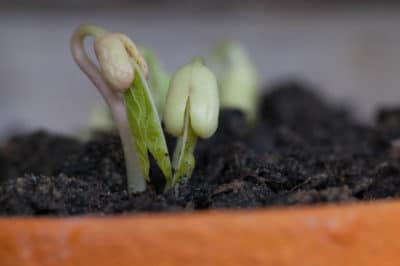Store Seeds Properly
Good germination begins with healthy, viable seed. Seed that gets wet or is exposed to wide temperature swings simply won’t germinate as well. Bean seeds should be stored in cool dry conditions in glass jars or other moisture-impermeable containers. For best long-term storage, store them in the freezer. When ready to use, let them slowly come to room temperature to prevent condensation.
Bean Varieties
Beans come in thousands of varieties. Here are some possibilities:
- String or snap beans – pole and bush varieties.
- Tepary beans – good for desert gardens.
- Lima beans – also available in pole and bush types.
- Runner beans – highly ornamental as well as edible.
- Winged beans – unusual shapes that taste like asparagus.
- Fava beans – the only cool-season bean.
Temperature Matters
Beans don’t like to be transplanted, so both soil and air temperature in the garden are important to germination. The seeds will germinate best when the soil temperature is at least 60°F (16°C), with an optimum temperature of 80°F (27°C). However, they will germinate reasonably well at any temperature between 60°F (16°C) and 85°F (29°C). Once the soil temperature gets to 95°F (35°C), germination is usually poor.
The Right Soil
Since beans prefer not to be transplanted, you must do all of your soil preparation before you plant. Beans like a pH of around 6.0 to 6.5, as do the beneficial bacteria that help them fix nitrogen in their roots. Too much nitrogen in the soil means extensive leaf growth at the expense of flowers and seed pods. Amend soil with well-rotted manure, organic compost or leaf mold. Make sure it drains well.
Best Watering Practices
You should give beans at least one inch of water a week. In hot, dry weather – especially if it’s windy – expect to use twice as much water. Bean seeds are susceptible to rot if too wet, though, so the soil should drain well. In very dry climates, a mulch can help conserve moisture, but in humid climates, it may encourage molds and mildew. Don’t work with wet plants, as it can spread disease.
Germination Problems
Bean seed germination usually takes about eight to 10 days. Cooler temperatures – especially soil temperatures below 60 degrees – can cause considerable delay and germination rates may be low. If the weather cooled off right after you planted, give your bean seeds two or three weeks before you declare a crop failure. Seed older than five years will not germinate as well as fresh seed.
